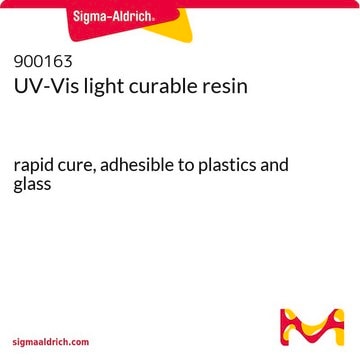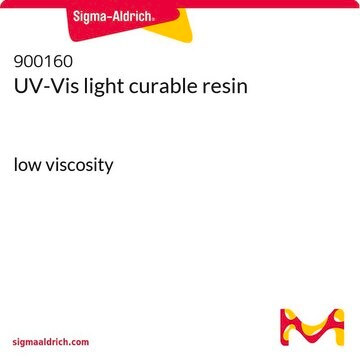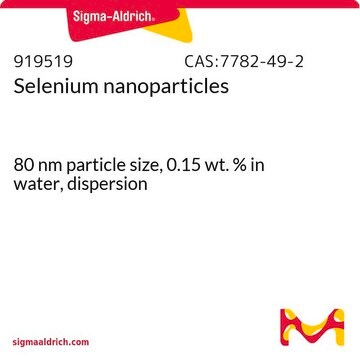推荐产品
環保替代產品特色
Design for Energy Efficiency
Use of Renewable Feedstocks
Learn more about the Principles of Green Chemistry.
品質等級
sustainability
Greener Alternative Product
環保替代類別
相关类别
一般說明
We are committed to bringing you Greener Alternative Products, which adhere to one or more of The 12 Principles of Greener Chemistry. This product belongs to enabling category of greener alternatives and it is bio-degradable and thus aligns with "Design for energy efficiency" and "Use of renewable feedstocks".UV curable resins are bio-based products which are solidified through a chain polymerisation reaction by uv rays. It shows excellent thermal and mechanical properties. Click here for more information.
應用
Printing process:
1) Preparation of resin - The material should be processed at room temperature. Before usage the material should be shaken well. Pour it slowly in the vat and wait a couple minutes, until smooth, bubble-free surface is obtained before starting the print job.
2) Printing process - As the suitable 3D printer examples and setting parameters stated above are only for general guidance purpose, user should always define the optimal settings according to nneds and printer.
3) Removing parts - Remove the parts carefully from the build platform with a suite able tool, for more information see the Instruction for Use of the used 3D-printer.
4) Cleaning process - The printed pieces can be cleaned firstly immersing it in glycol ether based solvent in an ultrasonic bath filled with water for 2 minutes, followed by rinsing with 2-propanol for a few seconds. Fine structures or holes may be better cleaned by using 2-propanol and a syringe or by separate brushing. The parts should be placed afterwards in a container filled with fresh 2-propanol and subsequently treated in an ultrasonic bath filled with water for 2 minutes. Blow dry the parts with pressure air/nitrogen, until the parts are clean.
5) Drying - Place the parts into a warming cabinet at 40 °C for 30 minutes.
6) Post-curing - The parts require adequate post curing to achieve the optimized final mechanical properties. After each post-curing cycle, the part needs to be flipped to achieve an even curing.
These proceedings are only general guidelines, the optimal printing settings as well as curing time must be defined by the user himself. The post-curing might differ by using different 3D-Printers and different post-curing units may require different settings.
1) Preparation of resin - The material should be processed at room temperature. Before usage the material should be shaken well. Pour it slowly in the vat and wait a couple minutes, until smooth, bubble-free surface is obtained before starting the print job.
2) Printing process - As the suitable 3D printer examples and setting parameters stated above are only for general guidance purpose, user should always define the optimal settings according to nneds and printer.
3) Removing parts - Remove the parts carefully from the build platform with a suite able tool, for more information see the Instruction for Use of the used 3D-printer.
4) Cleaning process - The printed pieces can be cleaned firstly immersing it in glycol ether based solvent in an ultrasonic bath filled with water for 2 minutes, followed by rinsing with 2-propanol for a few seconds. Fine structures or holes may be better cleaned by using 2-propanol and a syringe or by separate brushing. The parts should be placed afterwards in a container filled with fresh 2-propanol and subsequently treated in an ultrasonic bath filled with water for 2 minutes. Blow dry the parts with pressure air/nitrogen, until the parts are clean.
5) Drying - Place the parts into a warming cabinet at 40 °C for 30 minutes.
6) Post-curing - The parts require adequate post curing to achieve the optimized final mechanical properties. After each post-curing cycle, the part needs to be flipped to achieve an even curing.
These proceedings are only general guidelines, the optimal printing settings as well as curing time must be defined by the user himself. The post-curing might differ by using different 3D-Printers and different post-curing units may require different settings.
The Ultracur3D® photopolymer works with following technologies: Stereolithography (SLA), Digital Light Processing (DLP) and Liquid Crystal Display (LCD).
SLA can be used to create highly complex prototypes with a smooth surface finish. It offers high surface finishing and accuracy, while perfect for printing very large parts.
DLP is your go-to method when opting for a quick printing process without compromising on the quality of intricate parts. It provides high productivity, and can be used for larger and smaller parts.
LCD provides the opportunity to replace low and medium series injection molds with large parts. One of the biggest benefits of printing with Liquid Crystal Display (LCD) is to enable economic and large-scale production.
SLA can be used to create highly complex prototypes with a smooth surface finish. It offers high surface finishing and accuracy, while perfect for printing very large parts.
DLP is your go-to method when opting for a quick printing process without compromising on the quality of intricate parts. It provides high productivity, and can be used for larger and smaller parts.
LCD provides the opportunity to replace low and medium series injection molds with large parts. One of the biggest benefits of printing with Liquid Crystal Display (LCD) is to enable economic and large-scale production.
This product can be used in Material Jetting or Vat polymerization 3D printing techniques.
Ultracur3D® ST 45 can be sterilized by Ethylene Oxide (EtO) method*, but the color and mechanical property changes need to be taken into consideration by the user. When exposed to EtO sterilization, Ultracur3D® ST 45 demonstrates a 36 % increase in elongation at break and a 16 % decrease in modulus. The samples also show a 7 % decrease in ultimate strength. The test specimens show a small color change but become slightly lighter and more clear post-sterilization. EtOH residuals level after exposure were not recorded.
Testing conditions Ethylene Oxide Sterilization:
Testing conditions Ethylene Oxide Sterilization:
- Preconditioning temperature 48 °C
- Preconditioning humidity 60 %
- Preconditioning time 8 hours
- Chamber temperature 45 °C
- Vacuum 75 mbar A
- EO dwell time 3 hours
- EO concentration (calculated) 610 mg/l
- Postconditioning time 48 hours
- Postconditioning temperature 45 °C
Ultracur3D® ST 45 is a UV curable engineering resin that, upon cure, produces tough plastic material of yellowish color. This photocurable resin is suitable for LCD and DLP 3D printing using 355 nm, 385 nm or 405 nm light source for a variety of industrial and engineering applications requiring mechanical strength, impact resistance and heat stability.
The product is designed for fast and accurate additive manufacturing and possesses the following characteristics:
3D printed parts exhibit the following properties:
Note, these properties may vary based on the 3D printer used, thickness of printed layers, exposure duration per layer, as well as post cure method and its duration.
The product is designed for fast and accurate additive manufacturing and possesses the following characteristics:
- Viscosity (30C): 210 mPas (cone/plate rheometer)
- Density (liquid resin): 1.12 g/cm3 (ASTM D4052-18a)
- Density (printed part): 1.2 g/cm3 (ASTM D792)
3D printed parts exhibit the following properties:
- E Modulus: 2300 MPa (ASTM D638)
- Tensile Strength: 60 MPa (ASTM D638)
- Elongation at break: 25 % (ASTM D638)
- Impact Strength (notched): 20 J/m (ASTM D256)
- HDT (0.45MPa/1.82MPa): 73C/61C (ASTM D648)
- Hardness Shore: D 88 (ASTM D2240)
Note, these properties may vary based on the 3D printer used, thickness of printed layers, exposure duration per layer, as well as post cure method and its duration.
儲存和穩定性
Storage Conditions and Disposal Considerations:
Keep container tightly closed in a room temperature (below 30 °C and above 0 °C) and resin away from light. Keep container dry. If Material is not being used fill it back through a filter in the corresponding material bottle. The filter prevents to fill cured pieces or failed prints back into the bottle. Ultracur3D® ST 45 must be disposed of or incinerated in accordance with local regulations.
Keep container tightly closed in a room temperature (below 30 °C and above 0 °C) and resin away from light. Keep container dry. If Material is not being used fill it back through a filter in the corresponding material bottle. The filter prevents to fill cured pieces or failed prints back into the bottle. Ultracur3D® ST 45 must be disposed of or incinerated in accordance with local regulations.
法律資訊
Ultracur3D is a registered trademark of BASF 3D Printing Solutions GmbH
訊號詞
Danger
危險分類
Acute Tox. 4 Oral - Aquatic Chronic 3 - Eye Dam. 1 - Skin Irrit. 2 - Skin Sens. 1 - STOT RE 2 Oral
儲存類別代碼
10 - Combustible liquids
水污染物質分類(WGK)
WGK 3
我们的科学家团队拥有各种研究领域经验,包括生命科学、材料科学、化学合成、色谱、分析及许多其他领域.
联系技术服务部门











